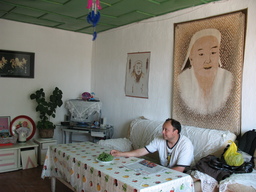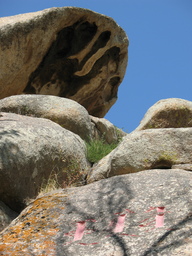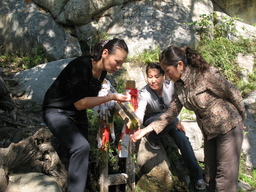Mongol Decor
 KHANDEKHAT (喇嘛教), China
KHANDEKHAT (喇嘛教), China
September 11, 2008
It doesn't matter whether it's a cloth yurt or a cement apartment block. Nor does it matter whether it's located in Mongolia or in China. The decoration inside all of the Mongolians' homes I've visited has been standard. Every single one of them was furnished with all three of these motifs:
- wolves
- horses
- enormous images of Genghis Khan
 Central to most of the homes I've visited has been a tapestry of Genghis Khan. Horses occasionally appear on such tapestries as well, though most often I've seen them as ceramic figurines. These figurines are often painted some color--such as green or yellow--which a real horse would never be. Cross-stitch patterns of horses' heads seem to be en vogue around Altai.
Central to most of the homes I've visited has been a tapestry of Genghis Khan. Horses occasionally appear on such tapestries as well, though most often I've seen them as ceramic figurines. These figurines are often painted some color--such as green or yellow--which a real horse would never be. Cross-stitch patterns of horses' heads seem to be en vogue around Altai.
Wolf imagery is everywhere throughout the Mongolian homes I've been inside--most often rendered in paintings. The home in which Meenday and I have been staying back in Altai has a life-sized wolf head mounted onto a wooden plaque. That's the first thing you see when opening the front door. At first I thought it was a real animal's head: it looked just like a hunter's trophy. I didn't inspect too closely but later figured that it was probably made from plastic or rubber.
We're making a day trip to a town a couple hours outside of Altai. Khandekhat is also known as Lamajiao in Chinese, a reference to the large number of Buddhist monasteries that were once spread around the area. The population is still mostly Mongol. Meenday's classmate Booyinagaar has a friend here, Bolmun, at whose home we've just finished lunch.
The highlight of our day has been a stroll through the terrain just out of town. Rounding boulders and following a river we made our way up to a spring sacred to local Mongolian Buddhists: 5-Fingered Spring.
 The "5 fingers" are a reference to an apparent impression of a handprint on the underside of a boulder. Meenday related the legend behind the spring and the handprint, though--on account of my language skills--I didn't understand it entirely.
The "5 fingers" are a reference to an apparent impression of a handprint on the underside of a boulder. Meenday related the legend behind the spring and the handprint, though--on account of my language skills--I didn't understand it entirely.
There was something about a great hero who came through the area. It was his handprint beneath the boulder. There might have been an epic battle. Later, water sprang from beneath the stone with special curative properties. A lame deer who drank from the stream could run again. A sick man was healed.
 We followed the rituals the local Mongolian Buddhists observe when visiting the spring. We first tied money inside strips of cloth. Next, we tied these pieces of cloth off around branches of nearby trees. The four of us then drank from the spring. Upon leaving we thanked the spring.
We followed the rituals the local Mongolian Buddhists observe when visiting the spring. We first tied money inside strips of cloth. Next, we tied these pieces of cloth off around branches of nearby trees. The four of us then drank from the spring. Upon leaving we thanked the spring.
Meenday and I be moving along from Khandekhat this evening. The distances aren't great but minibuses are infrequent and the roads to our next destination are indirect. We'll have to first return to Altai, then take a bus to the city of Burchin. From Burchin we'll have to get a shared taxi to cover the final stretch to our next stop: Lake Kanas.
 Central to most of the homes I've visited has been a tapestry of Genghis Khan. Horses occasionally appear on such tapestries as well, though most often I've seen them as ceramic figurines. These figurines are often painted some color--such as green or yellow--which a real horse would never be. Cross-stitch patterns of horses' heads seem to be en vogue around Altai.
Central to most of the homes I've visited has been a tapestry of Genghis Khan. Horses occasionally appear on such tapestries as well, though most often I've seen them as ceramic figurines. These figurines are often painted some color--such as green or yellow--which a real horse would never be. Cross-stitch patterns of horses' heads seem to be en vogue around Altai.
 KHANDEKHAT (喇嘛教), China
KHANDEKHAT (喇嘛教), China
 The "5 fingers" are a reference to an apparent impression of a handprint on the underside of a boulder. Meenday related the legend behind the spring and the handprint, though--on account of my language skills--I didn't understand it entirely.
The "5 fingers" are a reference to an apparent impression of a handprint on the underside of a boulder. Meenday related the legend behind the spring and the handprint, though--on account of my language skills--I didn't understand it entirely.
 We followed the rituals the local Mongolian Buddhists observe when visiting the spring. We first tied money inside strips of cloth. Next, we tied these pieces of cloth off around branches of nearby trees. The four of us then drank from the spring. Upon leaving we thanked the spring.
We followed the rituals the local Mongolian Buddhists observe when visiting the spring. We first tied money inside strips of cloth. Next, we tied these pieces of cloth off around branches of nearby trees. The four of us then drank from the spring. Upon leaving we thanked the spring.